Minds On
Ecosystem
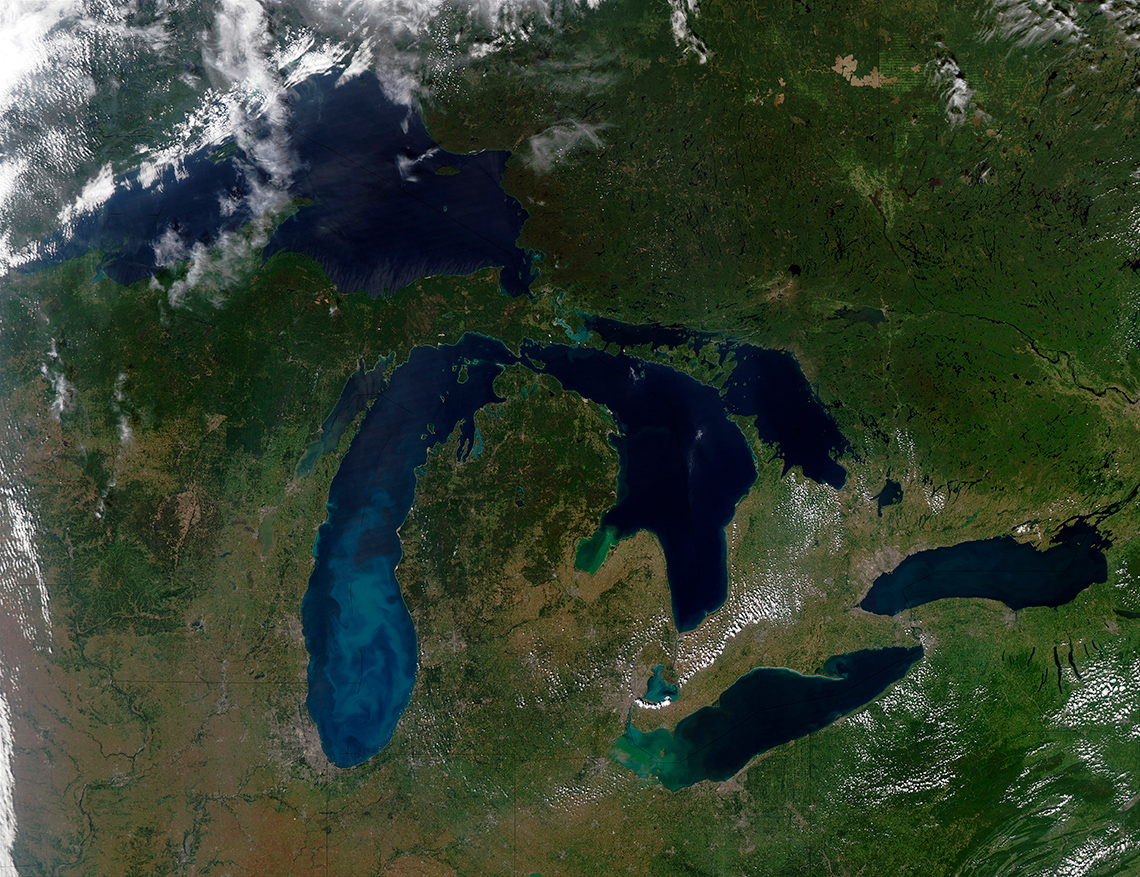
Great Lakes
An ecosystem is a complex system that contains living organisms and their environment, which interacts as a unit.
Brainstorm
Brainstorm
Let’s think about the Great Lakes – what do you think would be part of that ecosystem?
Brainstorm what you think exists in the Great Lakes ecosystem.
You may use words or illustrate pictures to demonstrate your thoughts.
Record your ideas in a notebook or another method of your choice.
True or false
Check out the following statements as you reflect on your previous knowledge about the Great Lakes. Reflect on which statement is true or false.
Select the correct answer, then press Check Answer to see how you did.
Action
Ontario connection
This learning activity highlights people, places, or innovations that relate directly to the province of Ontario. Enjoy the exploration!

The Great Lakes

Map of the Great Lakes
The Great Lakes, shared by Canada and the United States, are the largest freshwater system in the world, containing 18% of the world’s fresh surface water.
The Great Lakes are dynamic bodies of water that have adapted and changed over the past thousands of years. These lakes support a unique ecosystem and provide people with drinking water, energy, food, recreational opportunities, and economic advantages.
Exploring the lakes
Before exploring each lake, let’s learn more about the Scientific Research Process.
Explore this video to learn about the steps of the Scientific Research Process.
For this learning activity, we will focus on the learn, record, and think steps.
Press the following tabs to access information about each of the Great Lakes.
Lake Superior, which flows into Lake Huron to the southeast through St. Mary’s River, has 82,100 square kilometres of surface area. It has the world’s largest surface area of any freshwater lake. Lake Superior holds more water than the other four Great Lakes combined–12,100 cubic kilometres of water and is 406 metres deep.
Indigenous people arrived on its shores around 8000 years ago. The Ojibwa referred to it as gichigami, which means “Great Lake.” Superior, and the other Great Lakes came in existence through glacial movements that formed its basin.
Lake Superior’s shape was formed over 4000 years ago, but its shape is continuing to evolve. It is measured as rising by 53 cm every 100 years.
Lake Superior is bordered by Ontario (east and north), Minnesota (west), Michigan and Wisconsin (south). The natural resources found in and around the lake brought the Europeans to the area and silver was discovered in 1868, near the area of present-day Thunder Bay.
The fish species that are native to Lake Superior include trout, sturgeon, northern pike, and whitefish. This lake is the least affected by invasive species though a few aquatic species, such as Sea lampreys have found a way into the lake.
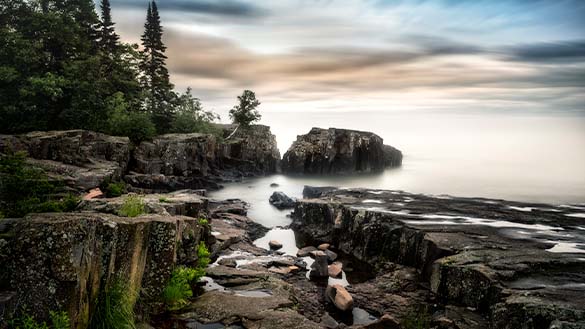
Lake Erie is the Great Lake that is furthest south. It is bordered by Ontario (north), Michigan (west), Ohio and Pennsylvania (south), and New York (east).
Lake Erie is the fourth-largest lake in terms of size. It is 25,655 km2. It has the smallest volume amount, at only 484 km3.
The name Erie comes from the Indigenous community of Erieehronons (French spelling for the Wyandotte or Huron Nation) or “people of the cougar.” This community lived on Erie’s south shore.
Lake Erie boasts a diversity of species because of its location. It’s three major peninsulas on the Canadian borders – Long Point, Pondeau, and Point Pelee – attract bird species and monarch butterflies, as well as over 70 species of trees, 50 types of insects and spiders, and diverse species of amphibians and reptiles.
Lake Erie has the highest population of all the Great Lakes. There are over 10.5 million people along the American border and 1.09 million along the Canadian border. This human presence has had a negative environmental impact on the lake and the ecosystems inside and surrounding the lake. Invasive species have also found their way into Lake Erie, which has impacted the ecosystem.
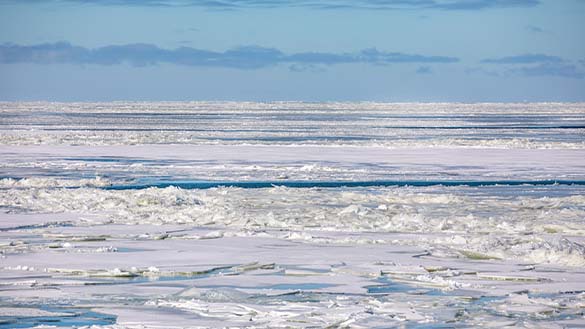
Ontario derives its name from Kaniatarí:io, a Kanien’kéha (Mohawk) word meaning “beautiful lake.” “Other Indigenous nations around the lake include the Mississaugas, whose settlement area included the present-day Greater Toronto Area, which was a nexus of Indigenous trade routes” (Bradburn, 2016).
Lake Ontario’s surface area of 10,009 km2 makes it the smallest of the Great Lakes. Its depth is the second highest, at 86m, and it is fourth in volume, at 1639 km3. Lake Ontario flows in from Lake Erie, via Niagara Falls, and out to the St. Lawrence River. 49% of the area surrounding the lake is covered in forest which includes species such as ash, basswood, beech, cedar, oak, and sugar maple.
The population surrounding Lake Ontario is about 5.6 million people. Rochester, New York borders Lake Ontario in the United States. On the Canadian side, Toronto, Hamilton, and Mississauga make up the highest populations but towns and cities along the south-eastern side of Ontario populate the lake all the way to Kingston.
The construction of the Welland Canal and the Erie Canal helped to expand shipping and other economic opportunities for Ontario, but it also introduced invasive species, like lampreys, into the lake. This along with over-fishing and pollution has led to negative impacts on the ecosystem of the lake.
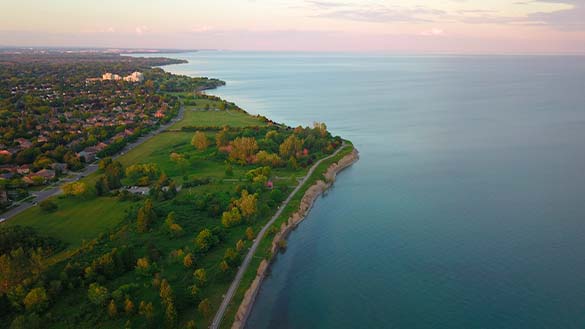
The name, Lake Michigan, comes from a word used in different Algonquian languages for “big lake.” The Indigenous nations who lived along the shores of Lake Michigan were the Fox, Illinois, Menominee, Miami, Odawa, Potawatomi and Winnebago, among others.
Lake Michigan is the third largest lake in surface area at 57,753 km2. It is the second largest in volume at 4918 km3 and is 85 m deep. This lake is the only one that is entirely in the United States with a population of 12 million people. Michigan borders the lake (northeast), as well as Wisconsin (northwest), Illinois (southwest), and Indiana (south). The largest cities are Chicago and Milwaukee, which both have large shipping ports on the lake.
Native fish in Lake Michigan include trout, whitefish, perch, and bass. Over-fishing and invasive species, namely lampreys, have had a negative impact on this ecosystem. Threats of invasive Asian carp have also become a concern. Forests surrounding the lake are mixed cover forests that include species like oak, pine, birch, beech, and sugar maple. On the west side of the lake, different tree species can be found, including basswood, walnut, oak, and maple trees. In Indiana, sand dunes provide habitats for over 1400 species of plants.
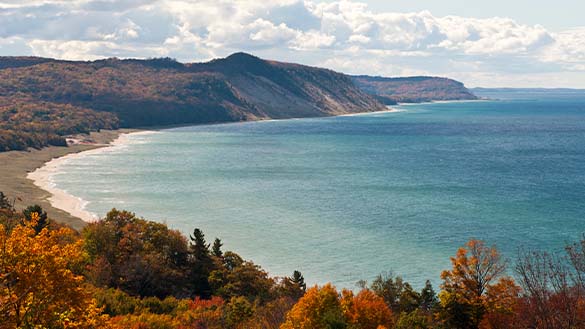
The waters of Lake Huron were named Gichi-aazhoogami-gichigami, or “great crossway sea” by the Ojibwe. This name was given because it was a route between Lake Michigan and Lake Superior.
Lake Huron is the second largest Great Lake in size. Its surface area is 59,600 km2 and is 59 m deep. It is the fifth biggest freshwater lake in the whole world! It has the largest shoreline and Georgian Bay is the largest bay of any Great Lake. It also has Manitoulin Island which is the largest freshwater island of all the Great Lakes.
It borders two of the other lakes – Ontario to the northeast and Michigan in the west.
Three million people live along the shores of Lake Huron. On the Canadian side, its largest cities are Sarnia and Collingwood. In the United States, the largest city is Port Huron.
Almost 70% of the shoreline of Lake Huron is forest. Species of trees include birch, aspen, ash, maple, cottonwood, and cedar. Manitoulin Island alone has over 1200 plant species. Wildlife at Lake Huron includes bird species, such as gulls, great blue herons, ducks, and cormorants. Approximately 90 different species of fish are found in the lake. These include whitefish, walleye, bass, trout, carp, northern pike, and smallmouth bass.
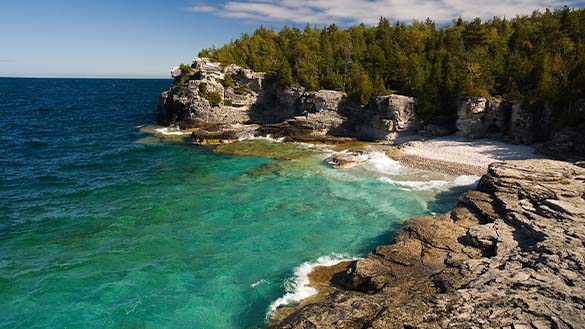
Try It
Your turn!
After exploring each Great Lake, choose one of the Great Lakes to explore further with the following questions:
- What areas of Canada and the U.S. border this Great Lake?
- What is the average water temperature?
- What is the origin of the name of the lake?
- What rivers or lakes are connected to this lake?
- What is the size of the lake in surface area, depth, and volume?
- What are species that are native to this area?
- What invasive species or threats exist in this lake?
You may refer to the information we previously explored or conduct your own research about the chosen lake..
Press ‘Hint’ to access a key detail.
What is an invasive species?
Invasive species are non-native species of plants and animals living outside the area that evolve, which disturbs an ecosystem that it has been introduced to.
Complete the “Great Lakes Organizer” in your notebook or using the following fillable and printable document. If you would like, you can use speech-to-text or audio recording tools to record your thoughts.
| Areas of Canada/U.S. that border this lake: | Average water temperature: | Origin of name: |
| Invasive species or threats to this Great Lake: | Rivers or lakes connected to this Great Lake: | |
| Species native to this area: | What is the size of the lake in surface area, depth, and volume? | |
| How did this information help you understand the ecosystem found in the Great Lake? |
Press the ‘Activity’ button to access Great Lakes Organizer.
Concerns?
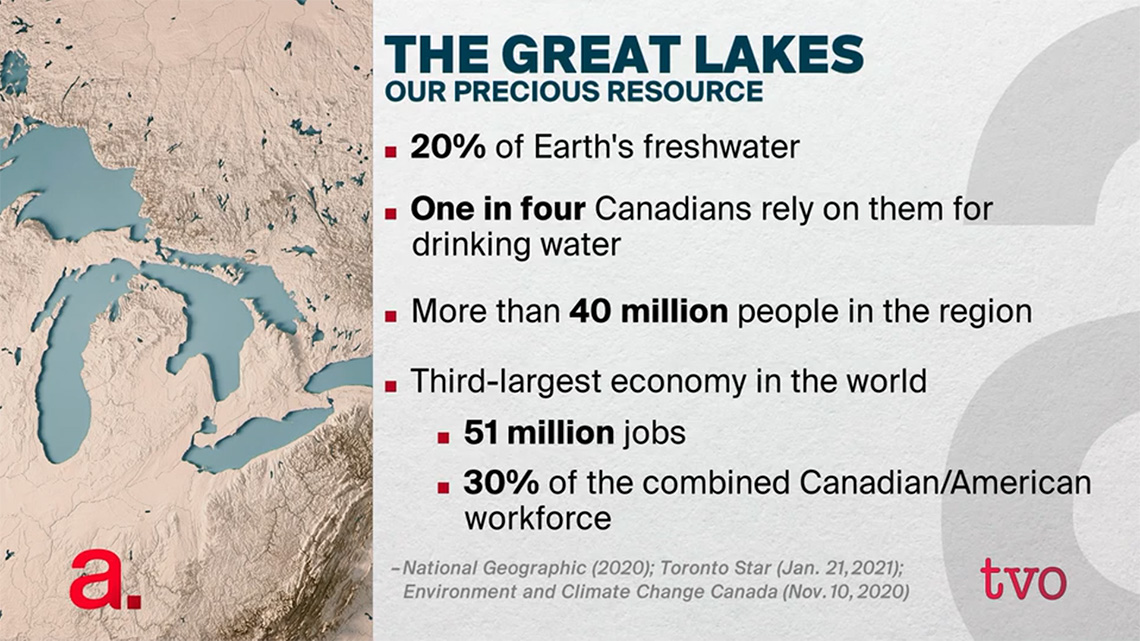
The Great Lakes are our precious resource. They are 20 percent of Earth’s freshwater. One in four Canadians rely on them for drinking water. There are more than 40 million people living in the region. It is also the third-largest economy in the world with a total of 51 million jobs, with approximately 30 percent of the combined Canadian and American workforce.
The Great Lakes are considered a precious resource to Canada and to the Indigenous peoples.
Access this video entitled “Making the Great Lakes Great Again” to learn more about how important the Great Lakes are.
As you are exploring, create a list of concerns or problems about the Great Lakes.
You may record these concerns in a notebook or another method of your choice.
When you’re ready, press “Let’s Check!” to access a sample list of concerns or problems about the Great Lakes.
- From 2014 to 2020, the Great Lakes went from 80% ice coverage to 17% (record low).
- Decreased ice has many implications, such as: increased coastal erosion, effects on the ecosystem, reduced winter recreation (ice fishing or skating).
- Large algae blooms showing up every summer caused by agricultural pollution and in the past, it was so bad (2015) the city of Toledo lost drinking water because the algae had toxins in it that poisoned the water.
- Different species, such as salmon, no longer run the rivers because of people and hydroelectric dams, which change traditional ways of using the Great Lakes.
- Indigenous communities have been concerned for hundreds of years about the health of the lakes.
- Pollution in the water over the years has contaminated the fish, and they can no longer be eaten.
- Increase in invasive species changed the entire ecosystem, such as Zebra mussels.
- Climate change has caused increased warming of the surface water, which can cause the algae blooms.
Indigenous knowledge
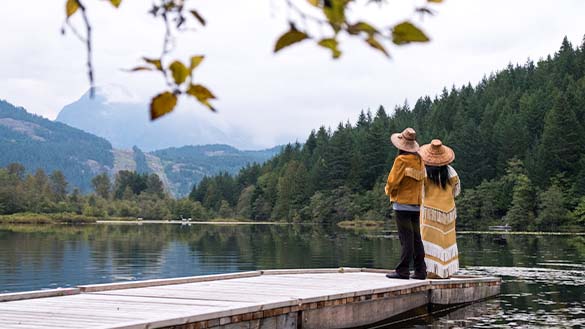
As climate change intensifies, existing and new challenges exist in the Great Lakes ecosystem, and there is great opportunity to learn from Indigenous communities who have lived in these territories since time immemorial, or as long as can be remembered.
Indigenous knowledge is being used to prepare for the changing environment driven by climate change.
The Anishinaabeg and their perspectives are being incorporated into a climate adaptation framework to help the Great Lakes. The Anishinaabeg include Odawa, Chippewa, Potawatomi, Ojibwe, Saulteaux, Mississaugas, Algonquin, Oji-Cree, and Nipissing nations.
This framework includes (but is not limited to) the following:
- There is consultation with cultural leaders, key community members, and Elders included with regards to the Great Lakes ecosystem. “Cultural leaders, community members, harvesters, elders, and other key individuals have important knowledges and perspectives that can inform climate adaptation activities.”
- There is also encouragement to learn through careful and respectful observations (gikinawaabi). “Indigenous knowledges and ways recognize plant, animal, and other spirit beings as our original teachers.”
- Another is to sustain ecological and cultural functions. “Climate adaptation actions will need to focus on maintaining the integrity of ecosystems and supporting cultural relationships in a changing climate.”
- Lastly, there is a push to reduce the risk of long-term impacts of disturbances. “Climate change is projected to increase the potential for severe disturbance events, such as wildfire, extreme wind, and ice storms.”
Making connections
Why is it important to include Indigenous knowledge and perspectives when learning about the impacts of climate change?
Record your ideas in a notebook or another method of your choice.
Invasive species
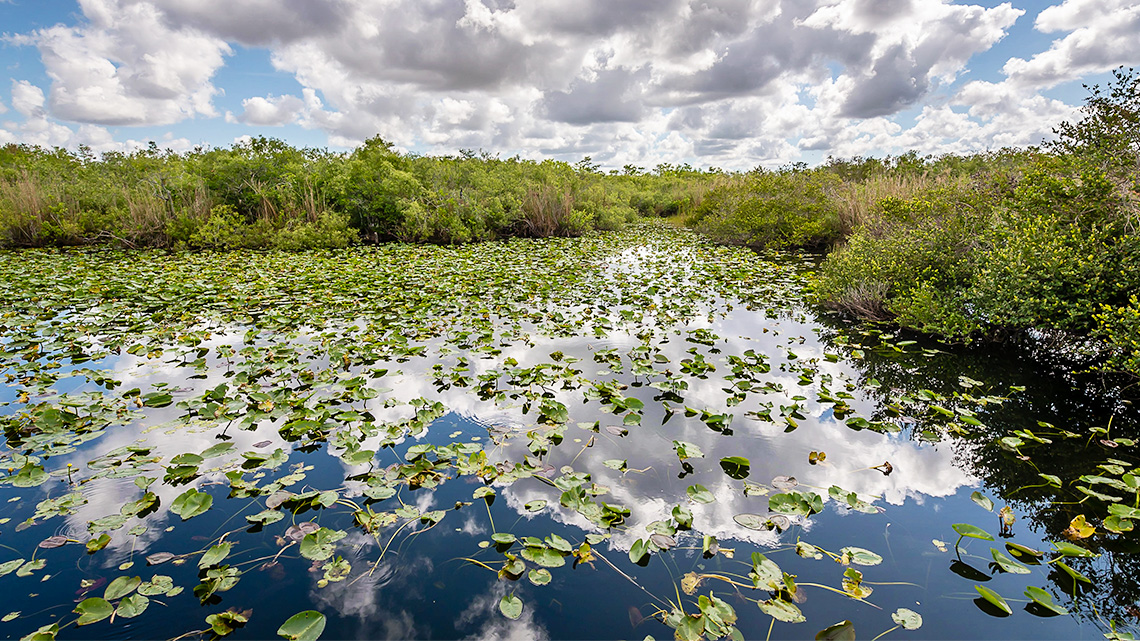
There are many different biotic and abiotic elements in the Great Lakes ecosystem.
Biotic elements are living elements in an ecosystem.
Abiotic elements are non-living elements in an ecosystem.
For this activity, sort the various elements in the Great Lakes as biotic or abiotic.
Choose “Biotic” if you think the element is a living element in an ecosystem.
Choose “Abiotic” if you think the elements is a non-living element in an ecosystem.
Did You Know?
Did you know?
Abiotic factors are temperature, depth, oxygen, and light, that have daily, seasonally, and yearly changes, due to natural and human influences.
This has caused life cycles, behaviours, and habitats of organisms in the Great Lakes to be altered. One change that has happened in the Great Lakes is the introduction of non-native plant and animal species.
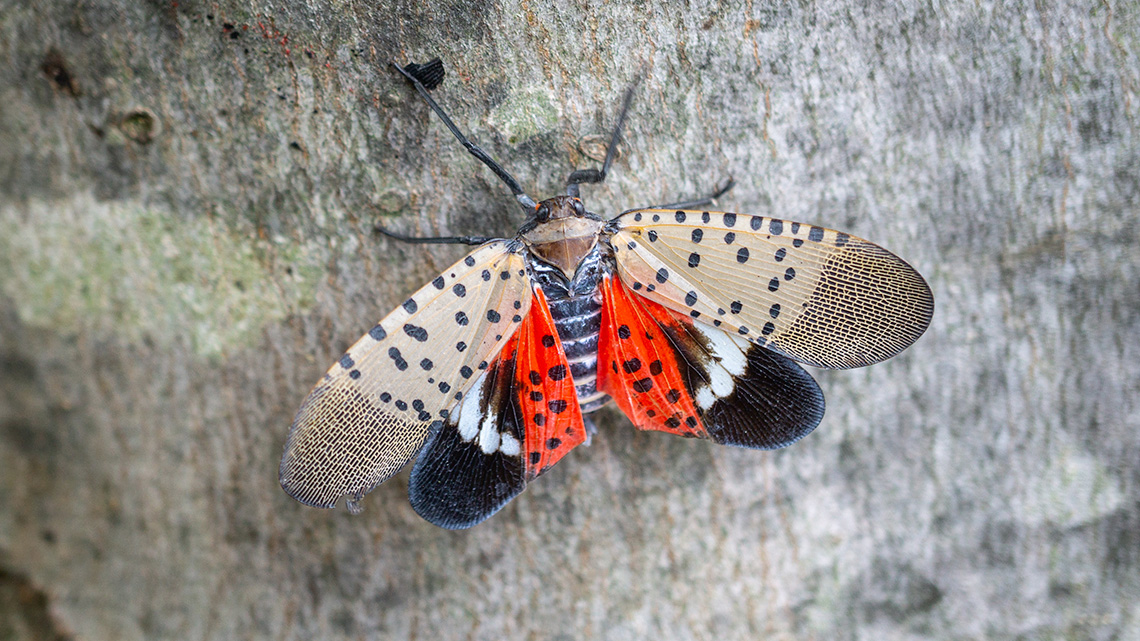
Recall that invasive species are a non-native species of plants and animals living outside the area that they evolved that disturb an ecosystem that it has been introduced. These species are in the Great Lakes and have establishedpopulations, multiplied rapidly, and caused long-lasting impacts on the Great Lakes.
Free from natural predators, invasive species can reproduce faster and compete with native species for food and shelter.
What do you think?
Let’s think and respond to the following questions:
- How do the abiotic and biotic components of an ecosystem interact?
- Create two interactions by choosing two abiotic and two biotic components in an ecosystem.
Record your interactions in a notebook or another method of your choice.
Press ‘Let’s Check!’ to access a possible response.
For example, oxygen levels in the lake interact with cattail plants. These plants need a specific level of oxygen to grow. If that level is affected, the health of the cattail plant is also affected.
Try It
Your turn!
1. First, choose at least one plant and one animal from the following list of invasive species:
| Invasive plants | Invasive animals |
|---|---|
|
Purple loosestrife Eurasian watermilfoil Common reed Frogbit Curly pondweed |
Eurasian ruffe Sea lamprey Round gobby Zebra mussels Asian carp |
2. Then, create a “fact sheet” about the invasive species that includes the following:
- name of the species
- a photo/drawing of the species
- description of the species (what is their appearance, how do they act, what do they eat, etc.)
- how they got to the Great Lakes
- how they are impacting the Great Lakes
- what is one way people can help find solutions to this problem
Record your fact sheet in a notebook or another method of your choice.
Press ‘Hint’ to access tips and additional details.
When researching your invasive species, it is important that you begin your search using websites, videos, audio recordings, or print resources from sources that would have reliable first-hand knowledge of the topic you’re researching.
Websites ending with .com, .org, and .net can be created and used by any person. Be careful when using these websites and ask yourself if these websites are credible or have bias. Those ending in .org are usually used by non-profit organizations, which may have an agenda of persuasion rather than education.
Websites ending in .edu are reserved for colleges and universities. Canadian websites have a .ca ending. It is important to consider using credible Canadian websites for research when possible!
Let’s review!
You may refer to the following checklists to guide your invasive species fact sheet.
I can choose resources by…
I can record Information by…
Consolidation
Review your learning

For each fact about the Great Lakes, select the missing word from the drop-down menu.
Final thoughts
In this learning activity, we have learned about how climate change and invasive species are impacting the Great Lakes and we have a great opportunity to learn from Indigenous communities on how to address these issues.
Using specific information from your learning today, consider the following activities:
Press the following tabs to access the review activities.
For this activity, respond to the following steps:
- Record a word that you thought was most important from this learning activity.
- Then, record a phrase that you would like to explore further.
- Lastly, record a sentence that sums up what you learned in this learning activity.
Record your synthesis in a notebook or another method of your choice.
If possible, share your responses and synthesis with a partner.
For this activity, complete a 3, 2, 1 review for this learning activity:
- three things that you liked or learned…
- two things that make more sense now…
- one question you are still left with…
Reflection
As you read the following descriptions, select the one that best describes your current understanding of the learning in this activity. Press the corresponding button once you have made your choice.
I feel…
Now, expand on your ideas by recording your thoughts using a voice recorder, speech-to-text, or writing tool.
When you review your notes on this learning activity later, reflect on whether you would select a different description based on your further review of the material in this learning activity.